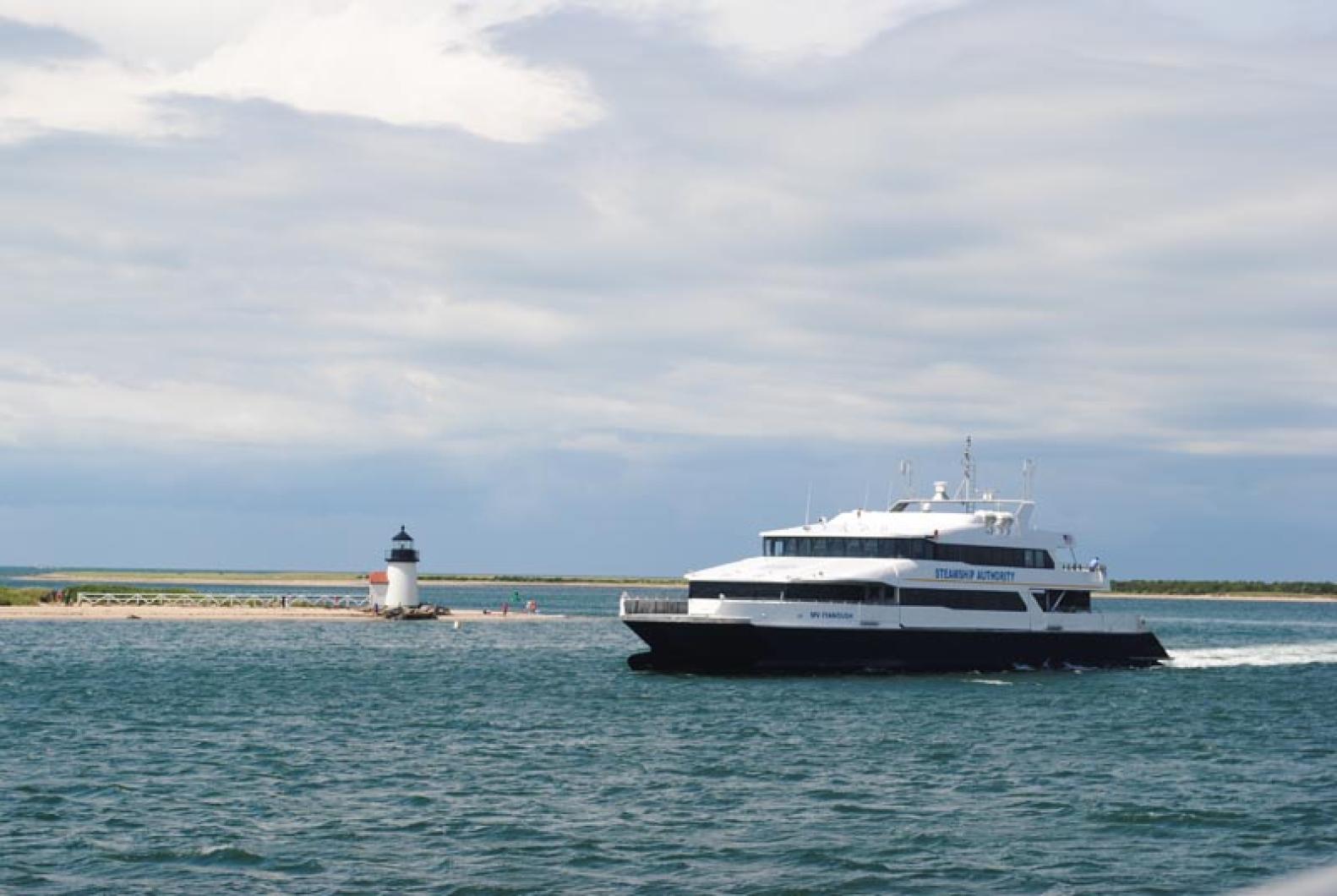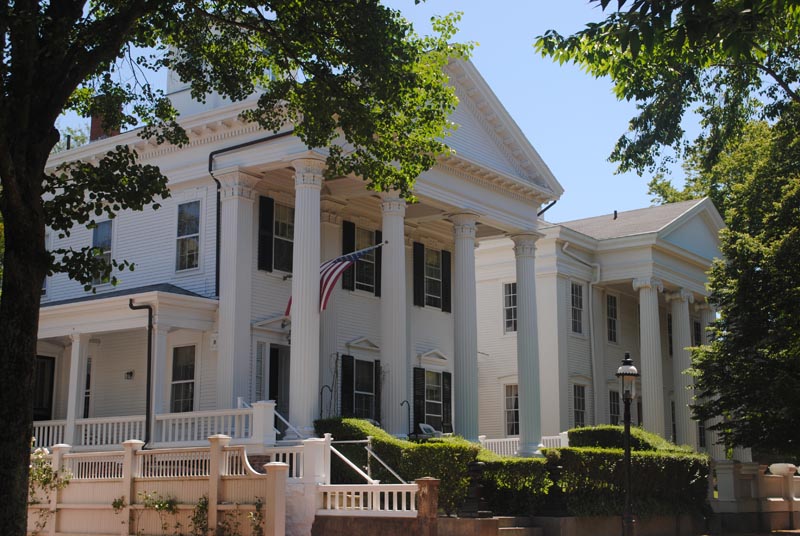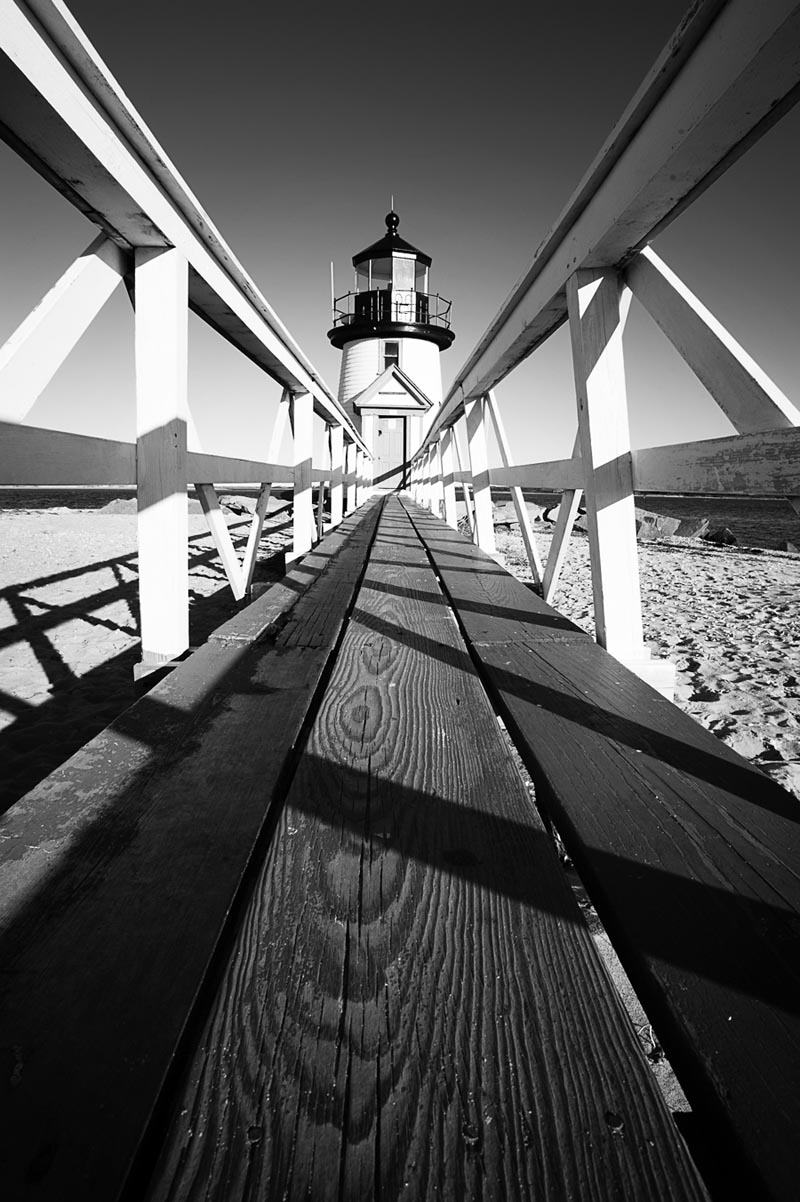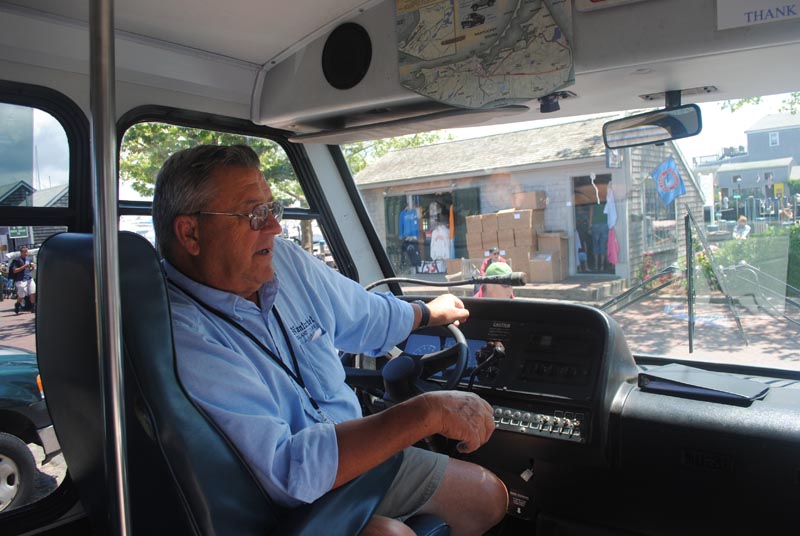Staring east from Chappaquiddick on a clear day, if you know where to look, a tiny white sliver peeks over the horizon. It’s the Nantucket water tower. Otherwise “the other island,” at only 12 miles away and barely over the curvature of the earth, might as well not exist to Vineyarders. And vice versa.
It is a peculiar fact that the Islands, united by geology, circumstance and history, are such strangers. On Monday this week, the once-a-day seasonal Hy-line ferry from Oak Bluffs to Nantucket was nearly empty (daily round trips between the Islands were discontinued in 2005 due to lack of demand). The route bridges the Muskeget channel, a gulf that separates two Islands and two cultures.
“We don’t think about the Vineyard very much. We’ve got our own life to live here,” said H. Flint Ranney, who serves on the Steamship Authority board of governors. Mr. Ranney’s attire at the monthly boat line meetings — complete with bow tie — identifies him as Nantucket’s representative as readily as his placard.
“I would say the relationship between the Islands is friendly but reserved. We know you’re there, but we’re way out in the ocean you know? I do have one serious question though: is it Oak Bluffs or Oaks Bluff?”
For Vineyarders planning their first trip to Nantucket, it’s instructive to know that it’s a great place to go to feel terrible about yourself. Everyone there looks fabulously healthy.
On Tuesday a clutch of bronzed, blond-haired, blue-eyed eight-year-olds in linen suits and espadrilles spilled out of the Nantucket Yacht Club, while downtown, teenagers clawed their way through the day’s haul of designer purchases to escape their tri-state-registered Range Rovers. Along the waterfront, backyards echoed with Dark and Stormy-fueled croquet matches, its contestants camouflaging their numbers zebra-like, in a disorienting jumble of seersucker, gingham, madras and pastels, most notably Nantucket Red. It’s a little like Edgartown on steroids.
If the Vineyard hosts a sizable contingent of the one per cent and even point one per cent, Nantucket requires scientific notation to identify its summer demographic. Like the Vineyard, rising property values on Nantucket have put a squeeze on locals in the housing market. This phenomenon reached its apotheosis in the spring of this year when a Polpis Harbor property went on the market for $59 million.
Geologically speaking, as twin offspring of the Laurentide ice sheet which retreated to the Arctic more than 10,000 years ago, the islands have much in common.
“When the glacial deposits came in, we weren’t left with a lot of rocky coastline,” said Nantucket beach manager Jeff Carlson on Wednesday. “We’re all glacial outwash here, so all sides of our Island are facing erosion.i
On the Vineyard, the impending demise of one Chappaquiddick home due to severe erosion near the breach at Norton Point will be an Island first. On Nantucket they have been waging battle against the encroaching Atlantic for decades, and town officials have lost count of the number of homes moved or lost to the sea.
Other problems common to both islands — their isolation, high cost of living and overdevelopment — seem magnified on the smaller island. (By the numbers, both in terms of geography and population, the Vineyard dwarfs Nantucket: Nantucket is 14 miles by 3.5 miles, the Vineyard over 20 miles long and 10 miles wide. Nantucket’s year-round population swells from 10,000 in the winter to over 50,000 in the summer. On Martha’s Vineyard those numbers jump from 16,000 to more than 105,000.)
Besides geology, the islands also share a human history. Both were inhabited by Wampanoags for thousands of years before European contact, though Nantucket’s did not survive that encounter, most dying from disease within decades.
Both Islands also enjoyed the golden age of whaling, though in this respect the Vineyard got trounced — 2,223 whaling voyages left from Nantucket, compared with only 254 out of Martha’s Vineyard. But that disparity did not prevent a commercial rivalry from developing between the two. One spurious legend claims that a certain Captain Hackett of Nantucket was especially reviled by Edgartonians, rustling as he would whole pods of whales costing as much as $50 million in today’s money, away from Vineyard ships.
“The old distrust still lingers today on the Vineyard,” wrote Gazette contributor W.R. Deeble in 2004. “Occasionally someone will mutter, or even cry out plaintively in the night, ‘Cap’n Hackett, give us back our whales!’”
The flames of that rivalry are still fed annually in inter-island contests, most notably in high school football with the storied Island Cup, and to a much smaller degree at the fishing contest between the Martha’s Vineyard Surfcasters Association and the Nantucket Angler’s Club held last week.
The Vineyard won both contests this year.
Though former surfcasters association president Janet Messineo maintains the fishing competition is held in a spirit of friendly respect, she couldn’t resist taking a jab at the other guys.
“The only reason they won last year was because we let them,” she said.
For summer visitors who have never experienced it, the atmosphere surrounding the Island Cup is difficult to exaggerate. When it is held on the Vineyard (every other year), a sea of purple signs sprouts up along Edgartown-Vineyard Haven Road, designed to intimidate Nantucket players on their short bus trip from the ferry to the high school. When it is held on Nantucket, as it was this year, and the Vineyard squad returns as conquering heroes, the Island’s fleet of fire engines greet them at the steamship terminal with sirens blaring.
In 2009, when Nantucket failed to scrape together the $12,000 required to charter a steamship vessel to the Vineyard to compete in the game, the result was devastating.
“When I had to tell them that there wasn’t going to be an Island Cup game ,a few of the kids welled up with tears in their eyes,” Vineyard coach Don Herman told the Gazette. “I just felt terrible for them, especially for the seniors.”
The cup was quickly restored the following year.
But outside of these rare competitions, the overwhelming attitude of the islands towards each other is apathy. An unscientific poll of patrons and staff at the Nantucket harborfront bar Cru on Monday revealed exactly what most Nantucketers think of their sister island: almost nothing at all. No ill will, no warmth. Most had never been.
Even Peter Benchley, author of Jaws, the film adaptation of which would irrevocably change Martha’s Vineyard, knew almost nothing of the island. In an interview with the Gazette last year, Jaws production designer Joe Alves described his experience scouting locations for the film.
“[Benchley] said, ‘Go to Nantucket, my parents live there. My mother will make you some cucumber and cream cheese sandwiches.’ I said, ‘What about this other Island, Martha’s Vineyard?’ And he said ‘Eh, there’s really nothing there.’ As it turned out he had never been there, and later when I asked him, he said Island people generally don’t go to the other island.”
Perhaps this cool indifference can be attributed in part to both islands’ prized self-sufficiency, though Nantucketers often scoff at the Vineyard’s proximity to “America” — just seven miles off the coast as opposed to 30.
Both islands are also fiercely protective of their history and vigilant against the erosion of their unique cultures. But business and homeowners on the Vineyard who complain about the long regulatory arm of the Martha’s Vineyard Commission would shudder to consider life under the iron fist of the Nantucket Historic District Commission. The body oversees the exterior of every building on the island and has even discussed regulating the interior of prominent downtown properties. To Vineyard eyes accustomed to wildly varied architecture that includes colorful gingerbread cottages, Victorian towers, white clapboard and Cape Cod-style houses with sagging porches — Nantucket is an architectural milieu of an almost stultifying sameness, an unending vista of cedar shingles, rose-covered trellises and hedges trimmed to geometric ideals.
The truth is, though, that the islands are kindred spirits. Thumbing through the weekly Inquirer and Mirror (Nantucket survives somehow with only one newspaper), stories abound that would be familiar to residents of either island: a family that owns the largest undeveloped tract on the island is struggling to balance the need for conservation with the lure of development, a letter to the editor illuminates the scourge of alcoholism on-island, and an editorial laments the brevity of shoulder season and the proliferation of 10-week pop-up shops.
Then there is the cabin fever that afflicts both islands, when the summer people return to the Eastern Megalopolis, taking their business with them.
“Those of us who live here like the solitude we experience in the off-season — up to a point,” an Inquirer and Mirror editorial reads. “We’re also clamoring for things to do in the quiet dead of winter.”
At the end of an hour and a half bus tour of Nantucket on Wednesday — which included an uneventful trip through both of that island’s roundabouts — native Nantucketer Ralph Hardy parked at the harbor and reminisced about the lost island of his youth, a story that resonates for islanders on both sides of the Muskeget channel.
“When I was in high school we used to come down here and open the bay scallops,” he said, gesturing toward an oceanfront row of upscale boutiques. “No electricity, no heat, we used kerosene lanterns and coal stoves. They had a big coal shed down the end of the wharf, and we’d go down and steal a bucket of coal. We’d open the scallops and fill one of them old Maxwell House coffee cans to the top. Nobody has a fishing shanty over there anymore.”
But Mr. Hardy also spoke to the unique species of pride endemic to islands, and especially of the special bragging rights granted to those lucky enough to be born on Martha’s Vineyard or Nantucket.
“You gotta be born here to be a native. We call everyone else washashores and off-islanders,” he said, laughing.
“But I’ve been here for 20 years,” he said, mimicking the protests of longtime visitors. “You’re an off-islander. Were you born here? No. You’re an off-islander. You’re a washashore.”










Comments (4)
Comments
Comment policy »